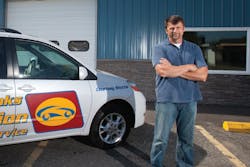Numbers are objective. Scott Tompkins knew that; he just wished they read differently. Forty percent. Sixty percent. Fifty-five percent. Each month, the closing ratios for his shop and his lone estimator were far below industry standards.
Sure, the fact that this estimator—who’d worked for Tompkins at Fairbanks Collision in Fairbanks, Alaska, for 15 years—had always been a model employee could allow Tompkins to overlook the numbers. The fact that the estimator had a family, that Tompkins knew this employee’s children by name, that Tompkins considered him a friend, could all help the shop owner turn a blind eye to the numbers.
But when it came to the health of his business, Tompkins wondered, could he continue to look the other way?
“It broke my heart to even think about having to let him go,” Tompkins says. “He’d been working for me for 15 years—always dependable, always early every day—but I’m looking at the numbers, and what can I do?”
The Backstory
Tompkins was confident on his first-ever day attending a Sherwin-Williams A-Plus Vision group meeting.
He opened his shop in 1989 at age 19, after spending several years doing paint and minor collision work out of his father’s mechanical shop. By 21, he had employees working for him and a growing reputation. And nearly 10 years after that, he stepped into that group meeting with a dozen years of ownership experience under his belt and a shop that, at least in his mind, was growing rapidly and on a pathway to success.
“I figured, at worst, I’d be middle of the pack,” he says. “Turns out I was just about the lowest shop in there.
“I’d never really looked at numbers, never really understood how to gauge my [profit and loss statement], and it turns out, we weren’t making any money.”
As his shop had grown, Tompkins had always simply thrown a new employee at every problem: The shop was overloaded in front, so he hired a front desk worker; the shop workflow was running into jams, so he hired a production manager.
And with every hire, his shop was wasting money that could’ve been saved with better efficiency.
“It took me a while to really look critically at my staff and realize the difference between production versus non-production employees, what the ratio needs to be and who I really needed in my shop,” he says.
Over the course of the next 10 years, Tompkins cleaned house—letting go a number of employees, including both his brother-in-law and his former high school tech teacher—and he improved his processes.
By 2012, Tompkins was running a profitable, efficient, $3 million-a-year business.
The Problem
Now, back to those closing ratio numbers: As someone who now prided himself on operating his shop like a true business, Tompkins simply couldn’t ignore the facts any longer.Preventing Mistakes
Because the estimator had always been an exemplary employee in every way aside from closing sales, he’d been somewhat overlooked throughout Tompkins’ purge of superfluous staff.
“And it’s not like we didn’t go over the numbers with him regularly,” Tompkins says. “We did. But, we’re in a smaller city; we’re not in some high-income metro area. And he would always assure me that there was no way we could do better than 60 percent given our market.”
But, by this point, 90 percent of Fairbank Collisions’ jobs came through DRP agreements. That number had grown significantly in the years preceding 2012, and as they grew, Tompkins believed his estimator’s excuses less and less.
“There’s no way we shouldn’t sell 90 percent of our work, when 90 percent of jobs coming in are from DRPs,” he says. “There’s just no way around it: It wasn’t the town or our customers; it was him.”
The Options
Tompkins says he had two choices: Work with the estimator and give him time to improve, or simply let him go.
“There had to be a change, so it was pretty black and white,” he says.
The Decision
Tompkins describes himself as being stubborn: “Some times you have to hit me over the head with a 2x4 to get something in my head.”
In this case, his P&L statement kept doing the trick.
“I always look at my P&L backwards,” he says. “I start at the bottom and look at net profit. Then, I work my way up the sheet to analyze how I got there.”
And he kept staring at the lack of sales.
The first thing he did was sit the estimator down, explain the situation to him and told him he had to substantially increase those numbers or he’d be let go. He thought the estimator needed more of an incentive, so he switched him from salary to commission. (“It’s something I should’ve always done anyway,” Tompkins admits.)
After the first month, nothing changed. After the second month, the closing ratio actually went down.
Tompkins had to let the employee go.
The Aftermath
Heartbreaking—that’s the word Tompkins uses to describe the whole situation. Yet, when he looks back on it, he doesn’t feel guilty.
“I felt I gave him every opportunity to improve, and he didn’t,” he says. “I gave him time—years, really; much more than I should’ve. He just couldn’t change with the times.”
Meanwhile, Tompkins had already been angling for his replacement. From talking to customers and talking with other shop employees, he realized that his estimator simply didn’t have the people skills to make a sale, to make customers feel that his shop was looking out for their best interests.
“I wanted someone who was great with customer service and knew how to make a sale,” he says.
And he recruited a 20-year veteran of the local General Motors dealership’s service department.
Within the new employee’s first month, closing ratios topped 80 percent. They now hover around 90 percent, and Tompkins expects his shop to have its highest revenue total ever in 2013.
The Takeaway
Looking back, Tompkins now realizes that he overlooked some of the previous estimator’s issues that should’ve been “dead giveaways.”
“We had some customer complaints every once in a while, where the customer didn’t feel like he even cared about making the sale and didn’t make the customer feel important,” he says. “Sometimes, you really have to just listen to what your customers are saying and evaluate why they’re feeling that way.”
Customer service index scores don’t always tell the whole story, Tompkins says; his shop has always been in the upper-90s, regardless of who was at the front desk. You need to reach out to people—both in and out of your shop—to get a real grasp of the way customers view your business.
And, as an owner, Tompkins says hiring, training and managing your people to fit your business’s needs is your most crucial job.
“We have to have the right people, the right type of people, in every position,” he says. “It’s why I now look for my front office people coming from a more retail-based background, rather than simply promoting from within.
“Hiring people to fix problems isn’t the answer. Hiring the right people for the right positions is.”




